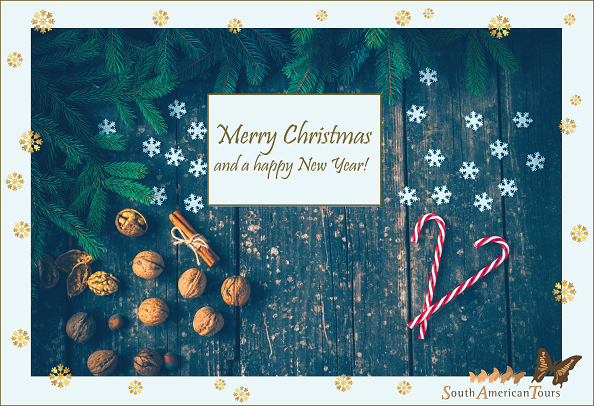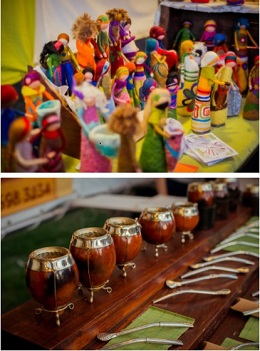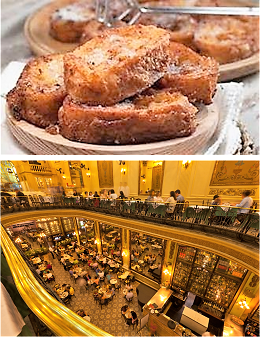|
 |

SAT NEWS - SPECIAL SEASON

Dear Travel Partner,
it's that special time of the year when many take a little break from their daily routine, unite with families and friends, and enjoy the upcoming holidays.
We wish you a wonderful Christmas and a good start into a peaceful, happy New Year!
We also want to take this opportunity to thank you for your ongoing support, trust and loyalty over the past difficult years. We are very much looking forward to a successful 2023, with many happy guests traveling safe and sound in our beautiful destinations.
A special thanks goes out to our amazing local teams!
They are working tirelessly to create wonderful travel experiences for our guests and are always committed to sending them home with unforgettable memories.
The success of SAT is the success of our teams!
In our last newsletter of the year we send you some South American Christmas spirit, and share a few of our local customs and traditions to celebrate this wonderful time. Enjoy reading!
All the best
your SAT Team
Follow us on Facebook, Instagram and Youtube for more news, products and impressions!
|
 |
|
 |

|
 |
|
 |
 |
Ecuador is known for its significant proportion of
indigenous peoples in the total population, most of them living in the Ecuadorian Andes. For these ethnical groups, the
sun has an enormous cultural and historical value. It represents the energy that provides light and heat -
Sun is Life! This is why each year on Dec 21, people celebrate the
Andean Summer Solstice, Kapac Raymi, a pre-Hispanic religious festival in tribute to the sun, that is considered to be one of the most important celebrations among the Andean cosmovision. It is also called
fiesta de los Niños or
Ancient Christmas. For the communities of the Andes, the festivities were
rites of integration with nature and with their gods, strongly associated to the agricultural cycle, the period of sowing and harvesting. In many communities there are also
initiation ceremonies for children to be introduced to adolescence. The celebration includes presents, food, music, fire and different type of rituals, such as
baths with sacred plants for the children, led by the wisest people from the community who transmit all the knowledge of the ancestors to the children. Finally, children are dressed up with new clothes, this is how
the new cycle begins. If you want to have another perspective of Christmas time, come to Ecuador over this period of the year and discover this unique celebration in the Andes! For more info contact SAT Ecuador! Picture credit: Ballet Latinoamericano Kallpañan
|
|
 |
 |
|
 |
 |

|
 |
|
 |
Peru is one of the
most diverse countries on the planet, and its diversity is also reflected in the celebration of Christmas. For example, Peru’s cultural richness is expressed in the
typical nativity scenes which are very popular in Peru. The colorful pieces
reflect all regions of Peru, from
coast to highland to rainforest. Created by the local communities, they show
characteristics of the area they present, like snow-covered volcanoes, tropical plants, and Andean crops. The holy family is placed in a stable with rustic characteristics of the countryside as well as typical animals of the region such as llamas, condors, alpacas, flamingos and tropical birds; the characters, including the Virgin Mary and St. Joseph, the baby Jesus, and the shepherds wear the typical clothing of the local community.
When coming to Peru, we definitely recommend strolling over the local markets and picking up one of those artisan-made nativity sets for your Christmas collection at home! In Cusco you find a very authentic Christmas market called Santuranticuy, which can be translated as the sale of saints; it is one of the largest arts and crafts fairs in Peru, and it takes over Cusco’s main square just the days before Christmas. You can find a great selection of crafts that range from traditional to contemporary, affordable to high-end and everything in between.
For suggestions for your unforgettable Christmas trip to Peru, please contact our local team. |
 |
|
 |
 |
 |
|
Montevideo, Uruguay’s capital, is known for its
rich culture and traditions, vibrant arts scene and a young, creative spirit. So no wonder the city has its own idea of a Christmas market during the special season: Ideas+. It is a local
Book and Print Fair located in the “Parque Rodó”, one of Montevideo’s main parks. Artists, publishers and artisans expose their works and also hold presentations, showcasing their art, ranging from local handicrafts made of different materials such as textiles, metals or wood to lamps, jewelry, books and music. Now in its 16th year, the fair is becoming a classic "go to" in Montevideo before Christmas, not only to look for possible Christmas gifts for loved ones, but also as a
popular cultural event. The purpose of the Ideas+ lies in the importance of
bringing art to the people in a public space, free of charge for the visitors. The organizers emphasize that their objective is to maintain a cultural space as such and not decline into a merely commercial proposal, aiming at a quality artistic exhibition.
Contact SAT Uruguay for more ideas of cultural packages in Montevideo and all Uruguay.
Picture credit: Ideas+
|
 |
|
 |
|
ARGENTINA - NUTCRACKER BALLETT
|
 |
|
With its imposing architecture and ornate decorations, the
Teatro Colón is one of the most stunning buildings in Buenos Aires. Inaugurated in 1908, it is considered to be one of the
most elegant opera houses in the world. In the run-up to Christmas, the renowned theater usually ends its season with the favored
Nutcracker Ballet. So it has become a wonderful tradition for the
porteños, the citizens of Buenos Aires, as well as international guests to attend a performance of this world-famous ballet presented in Rudolf
Nureyev’s choreography. "The Nutcracker" is a lovely
Christmas fairy tale for the whole family, composed to music by Piotr Ilich Tchaikovsky in 1890. The tale begins with a Christmas Eve celebration, and in the dreams of the young Clara, who receives a wooden nutcracker as a gift from her godfather. This nutcracker becomes a charming prince to take her through different worlds on her way to adulthood. A truly beautiful story in a festive setting.
Even if you don't make it to this amazing performance, don't miss a guided opera tour on your next trip to the capital. With no doubt the best experience you can have is attending one of the numerous opera or ballet presentations throughout the year to enjoy the theater's incredible acoustics.
For more cultural experiences in Buenos Aires, please contact our SAT Argentina team! |
|
 |
 |
|
 |
CHILE - FROM MONKEYS TAILS TO SUITCASES ON STREETS
|
 |

|
 |
|
 |
In Chile, kids have to show a lot of patience on Christmas eve until they finally get their Christmas gifts. On December 24, they usually wait until
midnight in order to hit the streets in search of
Viejito Pascuero, the Chilean version of Santa Claus. Once they get back to their homes, they will find the gifts under the Christmas tree, as Viejito Pascuero came just at 00:00 and brought the gifts. While the kids are busy unwrapping their gifts, the rest of the family would enjoy the typical Chilean Yuletide drink
Cola de Mono, or monkey’s tail, literally translated. The creamy cocktail is based on Pisco blended with coffee and milk, flavored with cinnamon, vanilla, nutmeg and cloves. We should probably tell you that this delicious concoction is rumored to have you “swinging like a monkey”, hence the name.
Chileans also have special traditions for
New Year’s Eve, like
getting on a chair right at midnight and waiting for the New Year, just before giving the New Year's hug. This symbolizes the hope that good things will be on the rise during the New Year. But our favorite custom is this: Travel junkies take to the streets at midnight with a suitcase in hand, to have a year full of travelling!! So we hope you keep that in mind, surprise those around you with that wonderful tradition, and then visit us in South America soon!
Click here to contact our SAT Chile team. |
 |
|
 |
COLOMBIA - NOCHE DE LAS VELITAS
|
 |
 |
|
At the end of November, Christmas air is already breathed in all houses and streets, but
December 7 is the official day in Colombia when the festivities begin with the
Night of the Little Candles, the
Noche de las Velitas. The parishioners
light hundreds of lights in the streets, sidewalks, parks and squares, they decorate their homes by placing candles and paper lanterns on windowsills, porches, balconies and in front of their doors, lighting the way to the Virgin to celebrate on the following day, Dec 8, the dogma of the Immaculate Conception of the Virgin Mary. On this day, a public holiday in Colombia,
a white flag with the image of the Virgin is hoisted in many houses. It is a joyous day, filled with music, food and drinks.
Bogota has a fabulous candle and light show in Plaza Bolivar; the city of
Medellin is most famous for its displays, with an extravaganza that focuses on the Medellin River and covers around 100 city parks, filled with light and color including an amazing light display along the river. The city is all wrapped up in an atmosphere of
magic and fantasy: giant gifts, houses, airplanes, flowers and characters alluding to Christmas are part of the immense light structures that are installed in the city, decorated to match the surrounding trees. And in the small colonial town of
Villa de Leyva, one of the biggest celebrations of this holiday occurs, when thousands of Colombians and visitors swarm from far and wide to be part of it. The
alumbrados (lights) are one of the
most important Christmas traditions for Colombians, as they mark the beginning of this very special season, a truly unique moment of the year.
Contact us for more info on special celebrations in Colombia. |
 |
|
 |
 |
 |
|
Around Christmas time, there is one specialty,
rabanada, which you will find popping up in almost every Brazilian home, restaurants and supermarkets. This
Portuguese/Brazilian version of French toast is traditionally served as a Christmas dessert. The dish arrived in Brazil from Portugal in colonial times:
The first mention of rabanada dates back to the 15th century. Brazilian fried bread differs from the French toast in a couple of ways. While the ingredients are the same: eggs, milk, and bread. The construction and cooking methods are different. For Rabanada, thick slices of stale bread are dipped first in milk and then in beaten eggs. This lets the milk soak into the bread first and coats only the exterior with the egg. The result is a fried bread that is crispy and eggy on the outside. But on the inside, it is wonderfully creamy and custardy.
Don’t miss trying a typical rabanada during your next stay in Brazil, for example in Rio de Janeiro’s most beautiful coffee house, Confeitaria Colombia, with its Art Nouveau flair dating back to 1894.
Contact us for more tasty ideas. |
 |
|
 |

|
 |
|
 |
South American Tours - Global Sales Office
South American Tours GmbH | Kaiserstr. 23 | 60311 Frankfurt am Main | Germany
Phone: +49 (0) 69 4058970 | Fax: +49 (0) 69 40589799
Mail: sales@southamericantours.com | www.southamericantours.com
South American Tours - Sales Office North America
Mail: sales-america@southamericantours.com
South American Tours - Sales Office Italy
Mail: sales.italy@southamericantours.com
Copyright © South American Tours 2012-2022
Imprint
South American Tours de Uruguay Agencia de Viajes S.A. | Buenos Aires 618, Piso 2, Oficina 201 | 11000 Montevideo | Uruguay
Tel.: +59 82 91 60 050 | Fax.: +59 82 91 55 406 | E-mail: info@southamericantours.com
Managing Director: Federico Büker | Registered Office: Montevideo | Local Court: Montevideo | Commercial Register: 1194 (Ministry of Tourism) | VAT identification no.: 215224020014

|
 |
|
Protection of data privacy and cancellation of the subscription:
This message has been sent to jzenner@southamericantours.com. If you do not want to receive mails in the future you can unsubscribe by clicking
here.
|
|
|
 |
|
 |
 |
|
|